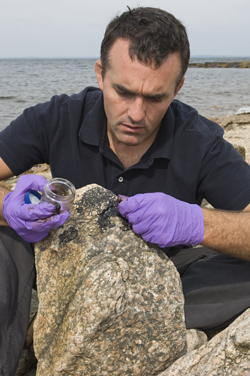In the wake of the November 7 spill of 58,000 gallons of fuel oil into San Francisco Bay, environmental chemist Chris Reddy of the Woods Hole Oceanographic Institution (WHOI) has collected and analyzed oil samples to help assess the long-term impact on the environment. With support from WHOI’s Coastal Ocean Institute and the environmental group Baykeeper, Reddy and colleagues collected oil-covered rocks from beaches around the Bay and used two-dimensional gas chromatography to delineate the precise chemical composition of the mixture. The “bunker oil” that spilled from the Cosco Busan and fouled at least 40 miles of California coastline is very similar to the oil that was spilled into Buzzards Bay (along the Massachusetts coast) in April 2003. Both contained polycyclic aromatic hydrocarbons (PAHs), which are known to be toxic and carcinogenic. Reddy, who specializes in examining the breakdown and longevity of oil compounds in the marine environment, collected this initial oil sample because long-term studies of impacts require an understanding of which oil compounds have weathered or degraded and which ones linger in the water and sediments. Reddy has forwarded his results to environmental groups in the Bay area, as well as the National Oceanic and Atmospheric Administration. He hopes to compare his samples with an original batch of oil directly from the ship to see how much the composition has already changed, and to have a baseline for assessing how nature breaks down the oil in the future. Related Links Originally published: November 1, 2007 Last updated: July 28, 2014 | |||||||||||||||
Copyright ©2007 Woods Hole Oceanographic Institution, All Rights Reserved, Privacy Policy. | |||||||||||||||


